lncRNA CASC19 Contributes to Radioresistance of Nasopharyngeal Carcinoma by Promoting Autophagy via AMPK-mTOR Pathway
- PMID: 33573349
- PMCID: PMC7866785
- DOI: 10.3390/ijms22031407
lncRNA CASC19 Contributes to Radioresistance of Nasopharyngeal Carcinoma by Promoting Autophagy via AMPK-mTOR Pathway
Abstract
Nasopharyngeal carcinoma (NPC) is one of the most frequent head and neck malignant tumors and is majorly treated by radiotherapy. However, radiation resistance remains a serious obstacle to the successful treatment of NPC. The aim of this study was to discover the underlying mechanism of radioresistance and to elucidate novel genes that may play important roles in the regulation of NPC radiosensitivity. By using RNA-seq analysis of NPC cell line CNE2 and its radioresistant cell line CNE2R, lncRNA CASC19 was screened out as a candidate radioresistance marker. Both in vitro and in vivo data demonstrated that a high expression level of CASC19 was positively correlated with the radioresistance of NPC, and the radiosensitivity of NPC cells was considerably enhanced by knockdown of CASC19. The incidence of autophagy was enhanced in CNE2R in comparison with CNE2 and another NPC cell line HONE1, and silencing autophagy with LC3 siRNA (siLC3) sensitized NPC cells to irradiation. Furthermore, CASC19 siRNA (siCASC19) suppressed cellular autophagy by inhibiting the AMPK/mTOR pathway and promoted apoptosis through the PARP1 pathway. Our results revealed for the first time that lncRNA CASC19 contributed to the radioresistance of NPC by regulating autophagy. In significance, CASC19 might be a potential molecular biomarker and a new therapeutic target in NPC.
Keywords: AMPK/mTOR; autophagy; lncRNA CASC19; nasopharyngeal carcinoma; radioresistance.
Conflict of interest statement
The authors declare no conflict of interest.
Figures
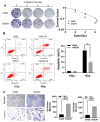
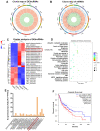
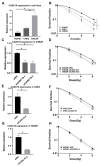
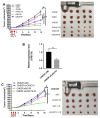
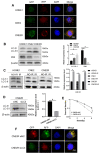
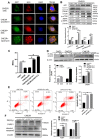
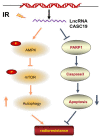
Similar articles
-
LncRNA CASC19 Enhances the Radioresistance of Nasopharyngeal Carcinoma by Regulating the miR-340-3p/FKBP5 Axis.Int J Mol Sci. 2023 Feb 3;24(3):3047. doi: 10.3390/ijms24033047. Int J Mol Sci. 2023. PMID: 36769373 Free PMC article.
-
LncRNA MINCR regulates irradiation resistance in nasopharyngeal carcinoma cells via the microRNA-223/ZEB1 axis.Cell Cycle. 2020 Jan;19(1):53-66. doi: 10.1080/15384101.2019.1692176. Epub 2019 Nov 24. Cell Cycle. 2020. Retraction in: Cell Cycle. 2022 Apr;21(8):875. doi: 10.1080/15384101.2022.2046812. PMID: 31760895 Free PMC article. Retracted.
-
VEGF knockdown enhances radiosensitivity of nasopharyngeal carcinoma by inhibiting autophagy through the activation of mTOR pathway.Sci Rep. 2020 Oct 1;10(1):16328. doi: 10.1038/s41598-020-73310-x. Sci Rep. 2020. PMID: 33004943 Free PMC article.
-
The Roles of mTOR Signaling in Nasopharyngeal Carcinoma: From Pathogenesis to Therapy.Curr Mol Pharmacol. 2024;17:e18761429293675. doi: 10.2174/0118761429293675240709061332. Curr Mol Pharmacol. 2024. PMID: 38988161 Review.
-
The Role of PTEN in Nasopharyngeal Carcinoma.Front Biosci (Landmark Ed). 2024 May 10;29(5):179. doi: 10.31083/j.fbl2905179. Front Biosci (Landmark Ed). 2024. PMID: 38812313 Review.
Cited by
-
M1 macrophages deliver CASC19 via exosomes to inhibit the proliferation and migration of colon cancer cells.Med Oncol. 2024 Oct 14;41(11):286. doi: 10.1007/s12032-024-02444-z. Med Oncol. 2024. PMID: 39402192
-
Metabolic reprogramming in the pathogenesis and progression of nasopharyngeal carcinoma: molecular mechanisms and therapeutic implications.Am J Cancer Res. 2024 Aug 25;14(8):4049-4064. doi: 10.62347/VYAT9271. eCollection 2024. Am J Cancer Res. 2024. PMID: 39267663 Free PMC article. Review.
-
Feedback loop between hypoxia and energy metabolic reprogramming aggravates the radioresistance of cancer cells.Exp Hematol Oncol. 2024 May 22;13(1):55. doi: 10.1186/s40164-024-00519-1. Exp Hematol Oncol. 2024. PMID: 38778409 Free PMC article. Review.
-
Role of long non-coding RNA in chemoradiotherapy resistance of nasopharyngeal carcinoma.Front Oncol. 2024 Feb 29;14:1346413. doi: 10.3389/fonc.2024.1346413. eCollection 2024. Front Oncol. 2024. PMID: 38487724 Free PMC article. Review.
-
Targeting RPA promotes autophagic flux and the antitumor response to radiation in nasopharyngeal carcinoma.J Transl Med. 2023 Oct 19;21(1):738. doi: 10.1186/s12967-023-04574-w. J Transl Med. 2023. PMID: 37858134 Free PMC article.
References
-
- Zheng Z.-Q., Li Z.-X., Zhou G.-Q., Lin L., Zhang L.-L., Lv J.-W., Huang X.-D., Liu R.-Q., Chen F., He X.-J., et al. Long Noncoding RNA FAM225A Promotes Nasopharyngeal Carcinoma Tumorigenesis and Metastasis by Acting as ceRNA to Sponge miR-590-3p/miR-1275 and Upregulate ITGB3. Cancer Res. 2019;79:4612–4626. doi: 10.1158/0008-5472.CAN-19-0799. - DOI - PubMed
MeSH terms
Substances
Grants and funding
LinkOut - more resources
Full Text Sources
Other Literature Sources
Miscellaneous

